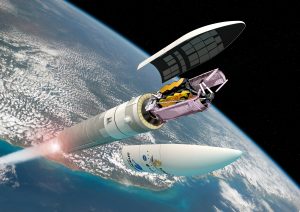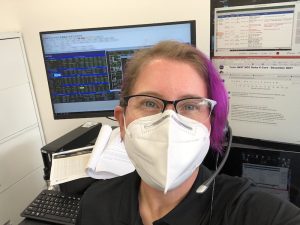While the team continues to work on unfolding Webb, we take a moment to learn more about the launch from two European Space Agency (ESA) representatives, Daniel de Chambure, Acting Head Ariane 5 Adaptation & Future Missions for ESA and Maurice Te Plate, JWST NIRSpec Systems and AIV Engineer for ESA. They provide details about the launch trajectory, which is the first phase of Webb’s journey before additional planned course corrections:
Europe’s Ariane 5 delivered Webb, with a launch mass of about 13,700 lbs (6200 kg), into the first phase of its planned trajectory toward its final position orbiting the L2 Lagrange point. As we all held our collective breath, lift-off was on December 25, 2021 at 7:20 am EST from Europe’s Spaceport in Kourou, French Guiana, for a flight lasting about 27 minutes before spacecraft separation.
About seven seconds after start of the ignition of the main stage cryogenic engine, the two solid propellant boosters were ignited, enabling liftoff. The launcher first climbed vertically for about 13 seconds, and then rotated towards the East. The solid boosters were jettisoned 2 mins and 14 sec after liftoff.
The fairing that protected Webb from the acoustic, thermal and aerodynamic stresses during the ascent, was jettisoned 3 minutes and 19 sec after liftoff. In order to protect the delicate thermal sunshield blankets of Webb, the fairing had been modified to minimize the shock of depressurization at separation. Updated venting ports allowed the pressure inside the fairing to properly equalize prior to opening. The recorded residual pressure was successfully below the required allowed maximum.

Once the atmospheric part of the flight was completed, Ariane’s onboard computers optimized the trajectory in real time, and brought the launcher to the intermediate orbit targeted at the end of the main stage propulsion phase, at 8 minutes and 35 seconds after launch. Ten seconds later, the HM7B engine of the cryogenic upper stage, with Webb still on top, was ignited and operated for a duration of 16 minutes. After engine shut-down, the upper stage underwent a number of positioning maneuvers with its attitude control system in order to separate Webb at the required attitude.
After separation, the upper stage underwent a delicate series of contamination and collision avoidance maneuvers, making sure that its thruster plumes did not impinge on Webb and its precious optics.
Finally, an end-of-life maneuver was performed to avoid potential long term collision risks with Webb.
Webb had started its journey to explore the Universe. Webb is on its way!
-Daniel de Chambure, Acting Head Ariane 5 Adaptation & Future Missions, ESA
-Maurice Te Plate, JWST NIRSpec Systems and AIV Engineer, ESA



